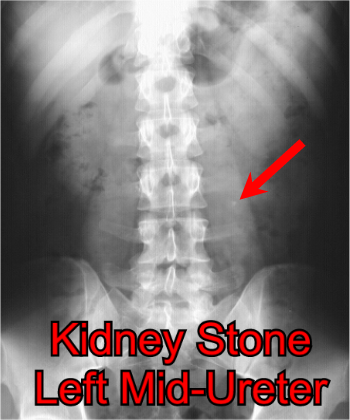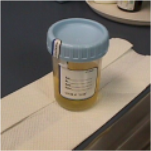|
Painful Urination
Painful urination is one of the classical symptoms of bladder
infection, along with frequency, urgency and sometimes hematuria. Such an
infection can be confirmed by a positive urine culture (>100,000 colonies/ml),
or strongly supported by a positive "dipstick" (for bacteria or leukocyte
esterase) and a clinically tender bladder (normally the bladder is not the least
bit tender).
Bladder infections are treated with broad-spectrum oral
antibiotics (Gantrisin, Bactrim DS, ampicillin, Keflex, Macrodantin, etc.).
Immediate relief of symptoms will occur with Pyridium 200 mg PO TID for 2 days.
In operational settings, cystitis is often
treated on the basis of symptoms and without confirming with cultures or
dipsticks. A woman complaining of urgency, frequency and dysuria very likely has
cystitis. With only limited resources, the main goal is to quickly treat any
possible UTI's, return the patient to full duty, and avoid the much more serious
problem of pyelonephritis.
Should symptoms persists despite a course of
broad spectrum antibiotics, a careful examination should be made and further
testing is appropriate.
Bladder infections among women in operational settings are
common:
-
Because of the difficulty in urinating (undressing in
field environments, limited sanitation, etc.), many women will intentionally
dehydrate, simply to avoid having to urinate. When successful, this
dehydration leads to urinary stasis, predisposing them toward bladder
infection.
-
To further avoid urinating in field settings, many
women will try to hold their urine as long as possible. This, too, leads to
urinary stasis and predisposes towards UTIs.
Gonorrheal Urethritis
Urinary frequency and burning in a patient with a history
of exposure to gonorrhea suggests gonorrheal urethritis.
The urethra is normally not tender. Should the
urethra be tender, particularly if combined with a purulent discharge,
urethritis should be suspected.
Paraurethral abscesses (infected Skene's glands),
and eversion of urethral epithelium are often found.
This diagnosis is confirmed by gram-negative
intracellular diplococci on Gram Stain or positive culture on Thayer-Martin
media (chocolate agar).
|
 Should the operational environment disallow this
precise workup, treatment is often provided on the basis of clinical suspicion
and symptoms, or after a failed course of broad-spectrum antibiotics provided
for a suspected UTI.
Treatment is:
-
Cefixime 400 mg orally in a single dose, OR
-
Ceftriaxone 125 mg IM in a single dose, OR
-
Ciprofloxacin 500 mg orally in a single dose, OR
-
Ofloxacin 400 mg orally in a single dose,
PLUS
Sexual partners also need to be treated. Skene's abscesses
should have I&D followed by daily packing with iodoform gauze for 2-4 days.
Non-gonorrheal Urethritis
These patients complain of
symptoms suggesting cystitis (frequency, burning, and urgency), but the
urine culture is negative and they do not improve on conventional antibiotic
therapy.
A purulent discharge
from the urethra may or may not be present, but the urethra is tender to
touch.
Cultures from the
urethra may be positive for chlamydia, Mycoplasma or Ureaplasma, but will be
negative for gonorrhea.
Treatment may be
started on the basis of clinical suspicion alone.
Treatment is:
-
Azithromycin 1 g orally in a
single dose, OR
-
Doxycycline 100 mg orally
twice a day for 7 days, OR
-
Erythromycin base 500 mg
orally four times a day for 7 days, OR
-
Erythromycin ethylsuccinate
800 mg orally four times a day for 7 days, OR
-
Ofloxacin 300 mg twice a day
for 7 days, OR
-
Erythromycin base 250 mg
orally four times a day for 14 days, OR
-
Erythromycin ethylsuccinate
400 mg orally four times a day for 14 days.
Herpes
Painful urination in
which the vulva burns when the urine drips across it can the primary symptom
of herpes. In this case, inspecting the vulva will reveal multiple, small
(1-2 mm), tender ulcers filled with grayish material and perhaps some
blisters that have not yet ruptured. Sometimes, the pain is so intense that
urination becomes complete misery. A Foley catheter until the symptoms
resolve is merciful.
Preferred treatment
(CDC) for an initial outbreak is:
-
Acyclovir 400 mg
orally three times a day for 7-10 days, OR
-
Acyclovir 200 mg
orally five times a day for 7-10 days, OR
-
Famciclovir 250 mg
orally three times a day for 7-10 days, OR
-
Valacyclovir 1 g
orally twice a day for 7-10 days.
Continue
to the PowerPoint Lecture...
|



